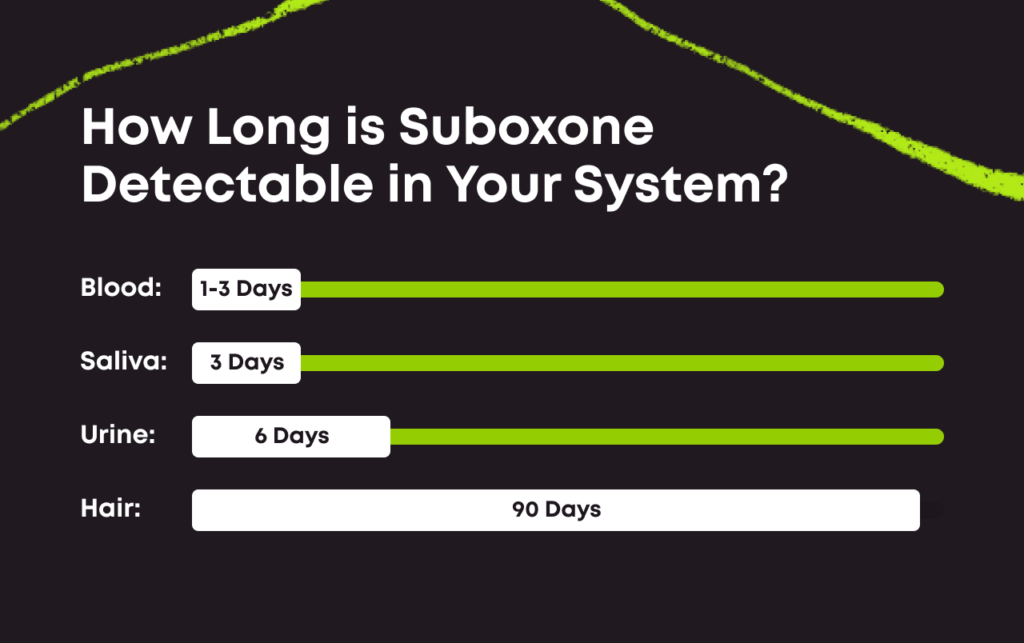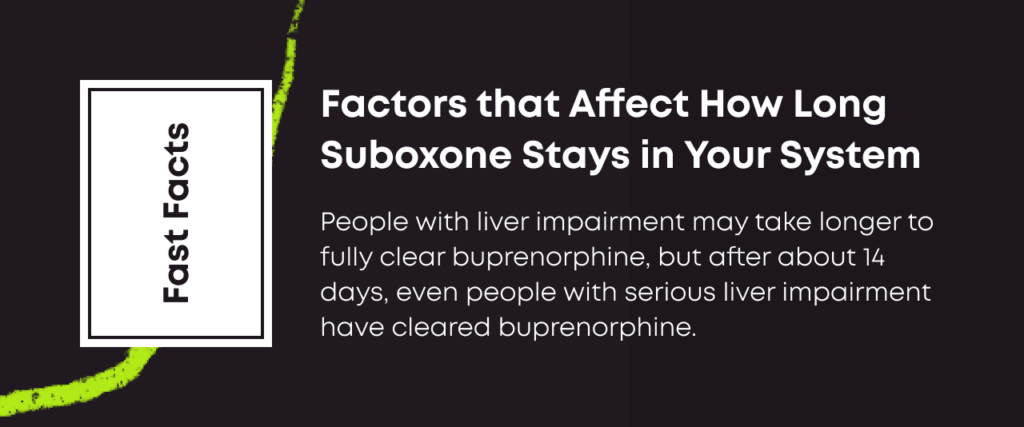Suboxone stays in your system for up to 10 days, on average. This is because of buprenorphine’s half-life, which ranges from 12 to 42 hours. The naloxone component of Suboxone has a shorter half-life of between 2 and 12 hours.
However, you will feel the desired effects of Suboxone for about 24 hours. This means relief from opioid cravings and withdrawal symptoms.
Depending on the type of drug test, Suboxone can be detected for longer than it stays in your system. Here are the Suboxone detection windows:
- Urine: Up to 6 days
- Blood: 1-3 days
- Saliva: Up to 3 days
- Hair: 90 days or more
The time Suboxone stays in your system can vary. Your health, age, genetics and more can impact how quickly drugs move out of your body.
Suboxone stays in your system for up to 10 days, depending on many factors.

How Long Suboxone Lasts in the Body
You’ll feel the effects of a Suboxone dose for about 24 hours. That’s why most people take the medication just once per day. But your body needs time to process the medication, and it may appear on a hair follicle test up to 90 days after taking it.
Suboxone is a prescription medication designed to help people overcome an addiction to opioids. Three million Americans have opioid use disorder (OUD).[1] Medications like Suboxone correct chemical imbalances caused by drugs and support long-term recovery.
Unlike other OUD medications (like methadone), Suboxone can be used at home from the very first dose. Suboxone also lasts in the body longer than methadone, which makes daily dosing convenient.
Suboxone contains buprenorphine and naloxone. A typical dose is 16 mg buprenorphine/4 mg of naloxone, used once per day.[2]
Buprenorphine is a Schedule III controlled substance. Most employers don’t include buprenorphine in routine drug tests. But if you’re concerned, tell the testing company about your medication and offer proof of your prescription. If your medication shows on a drug panel, your prescription will explain its presence.
How Long Buprenorphine Is Detectable by Test Type
| Test Type | Detection Duration |
| Urine | 6 days |
| Blood | 1-3 days |
| Saliva | 3 days |
| Hair | 90 days |
Understanding How the Body Metabolizes Suboxone
Suboxone contains two ingredients. You take just one dose, but your body has two elements to process. Buprenorphine stays in your system for longer than naloxone.
The two ingredients in Suboxone include the following:
- Buprenorphine: Buprenorphine works by binding to opioid receptors, which reduces cravings and withdrawal symptoms without inducing a euphoric high.
- Naloxone: Naloxone is not a controlled substance. It is not active at normal Suboxone doses. But take too much or try to inject your drug, and naloxone will activate and block your high.
Half-Life and Suboxone Metabolism
To understand how a drug leaves your body, you must learn about a drug’s half-life. This term refers to the time it takes for the body to process and remove 50% of the substance.
A half-life doesn’t vary by how much you take or how long you’ve taken it. The timeframe is always the same. Drugs tend to fall into the following two categories:
- Short half-lives: These medications have a rapid onset of effects and as such, last a relatively short period of time.
- Long half-lives: The effects of these medications come on slowly and last longer.
Each ingredient in Suboxone has a different half-life:[2]
- Buprenorphine: This drug has a long half-life of 12 to 42 hours, making it a long-acting drug.
- Naloxone: This drug has a short half-life of 2 to 12 hours, making it a fast-acting drug.
Because of buprenorphine’s relatively long half-life, it will take up to 10 days for your body to completely get rid of this partial opioid agonist.
How Long Does It Take for Suboxone to Start Working?
Suboxone will start working within minutes. Most people feel the desired effects of a dose within 20 to 45 minutes, meaning they’ll experience a reduction in cravings and withdrawal symptoms.[3]
Since the buprenorphine in Suboxone is a long-acting drug, you’ll feel the effects of the dose for about 24 hours.
If you completely stop taking Suboxone, there will be no trace of this medication — except in your hair — after three to six days. Naloxone will completely metabolize out of the body well before buprenorphine does.
The length of time Suboxone stays in your system doesn’t change depending on how long you’ve been taking this medication. In other words, you can’t store up doses in your tissues to prepare to quit. Healthy bodies metabolize the drug the same way, no matter how long they’ve used it.
Talk to your doctor about Suboxone if you have more questions about how quickly it will work and how long it will last.


Factors Affecting How Long Suboxone Stays in Your System
People metabolize different drugs at different rates, and Suboxone is no exception. These factors influence Suboxone metabolization:
- Your liver: Your liver processes key Suboxone ingredients, including both buprenorphine and naloxone. If you have significant liver problems, your doses will stay in your body longer.[4] You may also develop symptoms like yellowing skin or abdominal pain, as the buprenorphine in your medication could cause even more damage.
- Your age: Young people tend to metabolize drugs more quickly than older people do.
- Your genetics: Some people naturally process drugs faster than others. If you’re one of them, you’ll clear Suboxone quicker.
- Your body composition: Tall people with a lot of muscle tend to metabolize drugs faster than short people with a lot of body fat.
If you have questions about who is a good fit for Suboxone, reach out to your doctor.
Quick Answer
More than 100 million Americans have some form of liver disease. If you’re one of them, your Suboxone could last longer. And your doses could cause more damage. Ask your doctor for more information. Sources[2][5]
Frequently Asked Questions
We’ve compiled some of the most frequently asked questions about how long Suboxone stays in your system.
Most people feel the desired effects of a Suboxone dose within 20 to 45 minutes, meaning they’ll have relief from opioid withdrawal symptoms and cravings.
Yes. While Suboxone works best when doses dissolve in your mouth, a swallowed dose is still active. Some of the drug will still enter your system.
Using the drug in any way can make you test positive. Some companies set very low detection limits, so even a tiny dose could be enough to cause a positive result. However, standard drug panels don’t test for buprenorphine.
There’s no effective way to make Suboxone leave your body quickly. Your organs need time to process your doses. There’s also no reason to try to clear it from your system—drug tests don’t typically test for Suboxone and even if you test positive, you cannot be discriminated against for taking this medication for OUD.

Reviewed By Peter Manza, PhD
Peter Manza, PhD received his BA in Psychology and Biology from the University of Rochester and his PhD in Integrative Neuroscience at Stony Brook University. He is currently working as a research scientist in Washington, DC. His research focuses on the role ... Read More
- Azadfard M, Huecker MR, Leaming JM. Opioid addiction. StatPearls. Published April 29, 2023. Accessed June 27, 2023. https://www.ncbi.nlm.nih.gov/books/NBK448203/
- Suboxone prescribing information. U.S. Food and Drug Administration. Published March 2023. Accessed June 27, 2023. https://www.suboxone.com/pdfs/prescribing-information.pdf
- Starting Suboxone. British Columbia Centre on Substance Use. Accessed June 27, 2023. https://www2.gov.bc.ca/assets/gov/health/practitioner-pro/bc-guidelines/oud-induction-handout.pdf
- Buprenorphine. Liver Tox: Clinical and Research Information on Drug-Induced Liver Injury. Published November 24, 2020. Accessed June 27, 2023. https://www.ncbi.nlm.nih.gov/books/NBK548871/.
- How many people have liver disease? American Liver Foundation. Published August 5, 2022. Accessed June 27, 2023. https://liverfoundation.org/about-your-liver/facts-about-liver-disease/how-many-people-have-liver-disease/
Download Our Free Program Guide
Learn about our program, its effectiveness and what to expect
Related Content
Imagine what’s possible on the other side of opioid use disorder.
Our science-backed approach boasts 95% of patients reporting no withdrawal symptoms at 7 days. We can help you achieve easier days and a happier future.
